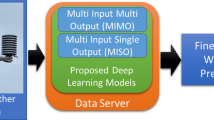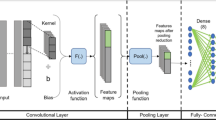Abstract
Accurate prediction of total electron content (TEC) is important for monitoring the behavior of the ionosphere and indeed a magnitude of interest to understand the properties and behavior of the Sun–Earth System. The conditions of this medium have a direct impact on a growing variety of critical technological infrastructure. This work presents a comparison between two different artificial neural networks (ANNs): an adaptive neuro-fuzzy inference system and nonlinear autoregressive neural network (NAR-NN) applied to TEC. Both ANNs where tested on four different geomagnetic locations on 4 1-week periods having a variety of geomagnetic disturbance levels. The effect of using different training period lengths and the system response for 60 and 30 min sampling rate TEC time series was investigated. NAR-NN shows a slightly better performance, being the higher difference during the greater perturbations. There is also a better response when sampling rates of 30 min are used.




Similar content being viewed by others
References
Bothmer V, Daglis IA (2007) Space weather: physics and effects. Springer, Berlin
Schrijver CJ, Kauristie K, Aylward AD, Denardini CM, Gibson SE, Glover A, Gopalswamy N, Grande M, Hapgood M, Heynderickx D et al (2015) Understanding space weather to shield society: a global road map for 2015–2025 commissioned by COSPAR and ILWS. Adv Space Res 55(12):2745–2807
Tsagouri I, Koutroumbas K, Elias P (2018) A new short-term forecasting model for the total electron content storm time disturbances. J Space Weather Space Clim 8:A33
Gao ZG, Zhang LQ (2006) Multi-seasonal spectral characteristics analysis of coastal salt marsh vegetation in Shanghai, China. Estuar Coast Shelf Sci 69(1–2):217–224
Le A, Tiberius C, van der Marel H, Jakowski N (2009) Use of global and regional ionosphere maps for single-frequency precise point positioning. In: Sideris MG (ed) Observing our changing earth. International Association of Geodesy Symposia, vol 133. Springer, Berlin, Heidelberg, pp 759–769
Meehan J, Fisher G, Murtagh W (2010) Understanding space weather customers in GPS-reliant industries. Space Weather 8(6):1–3
Board, Space Studies and National Research Council and others (2009) Severe space weather events: understanding societal and economic impacts: a workshop report. National Academies Press
Bust GS, Mitchell CN (2008) History, current state, and future directions of ionospheric imaging. Rev Geophys 46(1):RG1003
Dow JM, Neilan RE, Rizos C (2009) The international GNSS service in a changing landscape of global navigation satellite systems. J Geod 83(3–4):191–198
Hernandez-Pajares M, Juan JM, Sanz J, Orus R, Garcia-Rigo A, Feltens J, Komjathy A, Schaer SC, Krankowski A (2009) The IGS VTEC maps: a reliable source of ionospheric information since 1998. J Geod 83(3–4):263–275
Garcia-Rigo A, Monte E, Hernandez-Pajares M, Juan JM, Sanz J, Aragon-Angel A, Salazar D (2011) Global prediction of the vertical total electron content of the ionosphere based on GPS data. Radio Sci 46(06):1–3
Erdogan E, Schmidt M, Seitz F, Durmaz M (2017) Near real-time estimation of ionosphere vertical total electron content from GNSS satellites using B-splines in a Kalman filter. Ann Geophys 35(2):263–277
Jakowski N, Mayer C, Hoque MM, Wilken V (2011) Total electron content models and their use in ionosphere monitoring. Radio Sci 46(6):1–11
Takahashi H, Wrasse CM, Denardini CM, Pádua MB, Paula ER, Costa SMA, Otsuka Y, Shiokawa K, Monico JF, Ivo A et al (2016) Ionospheric TEC weather map over South America. Space Weather 14(11):937–949
Mendoza LPO, Meza AM, Paz JMA (2019) A multi-GNSS, multi-frequency and near real-time ionospheric TEC monitoring system for South America. Space Weather 17(5):654–661
Badeke R, Borries C, Hoque MM, Minkwitz D (2018) Empirical forecast of quiet time ionospheric Total Electron Content maps over Europe. Adv Space Res 61(12):2881–2890
Williscroft L-A, Poole AWV (1996) Neural networks, foF2, sunspot number and magnetic activity. Geophys Res Lett 23(24):3659–3662
Wintoft P, Cander LR (2000) Twenty-four hour predictions of f0F2 using time delay neural networks. Radio Sci 35(2):395–408
Tulunay E, Senalp ET, Radicella SM, Tulunay Y (2006) Forecasting total electron content maps by neural network technique. Radio Sci 41(4):1–12
Tebabal A, Radicella SM, Nigussie M, Damtie B, Nava B, Yizengaw E (2018) Local TEC modelling and forecasting using neural networks. J Atmos Sol Terr Phys 172:143–151
Mallika IL, Ratnam DV, Ostuka Y, Sivavaraprasad G, Raman S (2019) Implementation of hybrid ionospheric TEC forecasting algorithm using PCA-NN method. IEEE J Sel Top Appl Earth Obs Remote Sens 12(1):317–381
Orus R, Hernandez-Pajares M, Juan JM, Sanz J (2005) Improvement of global ionospheric VTEC maps by using kriging interpolation technique. J Atmos Sol Terr Phys 67(16):1598–1609
Popoola A, Ahmad S, Ahmad K (2004) A fuzzy-wavelet method for analyzing non-stationary time series. In: Proceedings of the 5th international conference on recent advances in soft computing, pp 16–18
Akyilmaz O, Arslan N (2008) An experiment of predicting Total Electron Content (TEC) by fuzzy inference systems. Earth Planets Space 60(9):967–972
Takagi T, Sugeno M (2008) Fuzzy identification of systems and its applications to modeling and control. IEEE Trans Syst Man Cybern 15(1):116–132
Isasi Vinuela P, Galvan Leon IM (2004) Redes de neuronas artificiales. Editorial Pearson Educacion SA, Madrid
Mahmut F, Mahmud G (2008) Hydrological time-series modelling using an adaptive neuro-fuzzy inference system. Hydrol Process Int J 22(13):2122–2132
Nuri H, Milagrosa A, Julio T (2009) Comparison between neuro-fuzzy and fractal models for permeability prediction. Comput Geosci 13(2):181–186
Melin P, Soto J, Castillo O, Soria J (2012) A new approach for time series prediction using ensembles of ANFIS models. Expert Syst Appl 39(3):3494–3506
Walia N, Singh H, Sharma A (2015) ANFIS: adaptive neuro-fuzzy inference system a survey. Int J Comput Appl 123(13):32–38
Brown M, Harris CJ (1994) Neurofuzzy adaptive modelling and control. Prentice Hall, Upper Saddle River
Jang J-SR (1993) ANFIS: adaptive-network-based fuzzy inference system. IEEE Trans Syst Man Cybern 23(3):665–685
Ruiz L, Cuellar M, Calvo-Flores M, Jimenez M (2016) An application of non-linear autoregressive neural networks to predict energy consumption in public buildings. Energies 9(9):684
Lewis CD (1982) Industrial and business forecasting methods: a practical guide to exponential smoothing and curve fitting. Butterworth-Heinemann, Oxford
Prölss G (2012) Physics of the earth’s space environment: an introduction. Springer, Berlin
Tsagouri I, Belehaki A, Moraitis G, Mavromichalaki H (2000) Positive and negative ionospheric disturbances at middle latitudes during geomagnetic storms. Geophys Res Lett 27(21):3579–3582
Belehaki A, Tsagouri I (2001) Study of the thermospheric-ionospheric response to intense geomagnetic storms at middle latitudes. Phys Chem Earth Part C Sol Terr Planet Sci 26(5):353–357
Fuller-Rowell TJ, Codrescu MV, Moffett RJ, Quegan S (1994) Response of the thermosphere and ionosphere to geomagnetic storms. J Geophys Res Space Phys 99(A3):3893–3914
Kutiev I, Muhtarov P, Cander LR, Levy MF (1999) Short-term prediction of ionospheric parameters based on auto-correlation analysis. Ann Geophys 42(1):121–127
Muhtarov P, Kutiev I, Cander L (2002) Geomagnetically correlated autoregression model for short-term prediction of ionospheric parameters. Inverse Probl 18(1):49
Cander LR (2015) Forecasting foF2 and MUF (3000) F2 ionospheric characteristics—a challenging space weather frontier. Adv Space Res 56(9):1973–1981
Gonzalez WD, Jo-Ann J, Kamide Y, Kroehl HW, Rostoker G, Tsurutani BT, Vasyliunas VM (1994) What is a geomagnetic storm? J Geophys Res Space Phys 99(A4):5771–5792
Hargreaves JK (1992) The solar-terrestrial environment: an introduction to geospace-the science of the terrestrial upper atmosphere, ionosphere, and magnetosphere. Cambridge University Press, Cambridge
Cander LR (2019) Ionospheric space weather forecasting and modelling. In: Ionospheric space weather, pp 135–178
Haykin S, Thomson DJ (1998) Signal detection in a nonstationary environment reformulated as an adaptive pattern classification problem. Proc IEEE 89(11):2325–2344
Acknowledgements
This research was supported by ANPCyT Grant PICT 2015-3710 and UNLP Grant 11/G142. The authors thank the International GNSS Service (ftp://cddis.gsfc.nasa.gov) for providing the IONEX data and to the NASA/GSFC’s Space Physics Data Facility’s OMNIWeb Plus Service. Finally, we thank the two anonymous reviewers for their insightful comments on the original manuscript.
Author information
Authors and Affiliations
Corresponding author
Ethics declarations
Conflict of interest
The authors declare that there are no conflict of interest regarding this manuscript.
Additional information
Publisher's Note
Springer Nature remains neutral with regard to jurisdictional claims in published maps and institutional affiliations.
Rights and permissions
About this article
Cite this article
Pérez Bello, D., Natali, M.P. & Meza, A. Comparison of adaptive neuro-fuzzy inference system and recurrent neural network in vertical total electron content forecasting. Neural Comput & Applic 31, 8411–8422 (2019). https://doi.org/10.1007/s00521-019-04528-8
Received:
Accepted:
Published:
Issue Date:
DOI: https://doi.org/10.1007/s00521-019-04528-8




